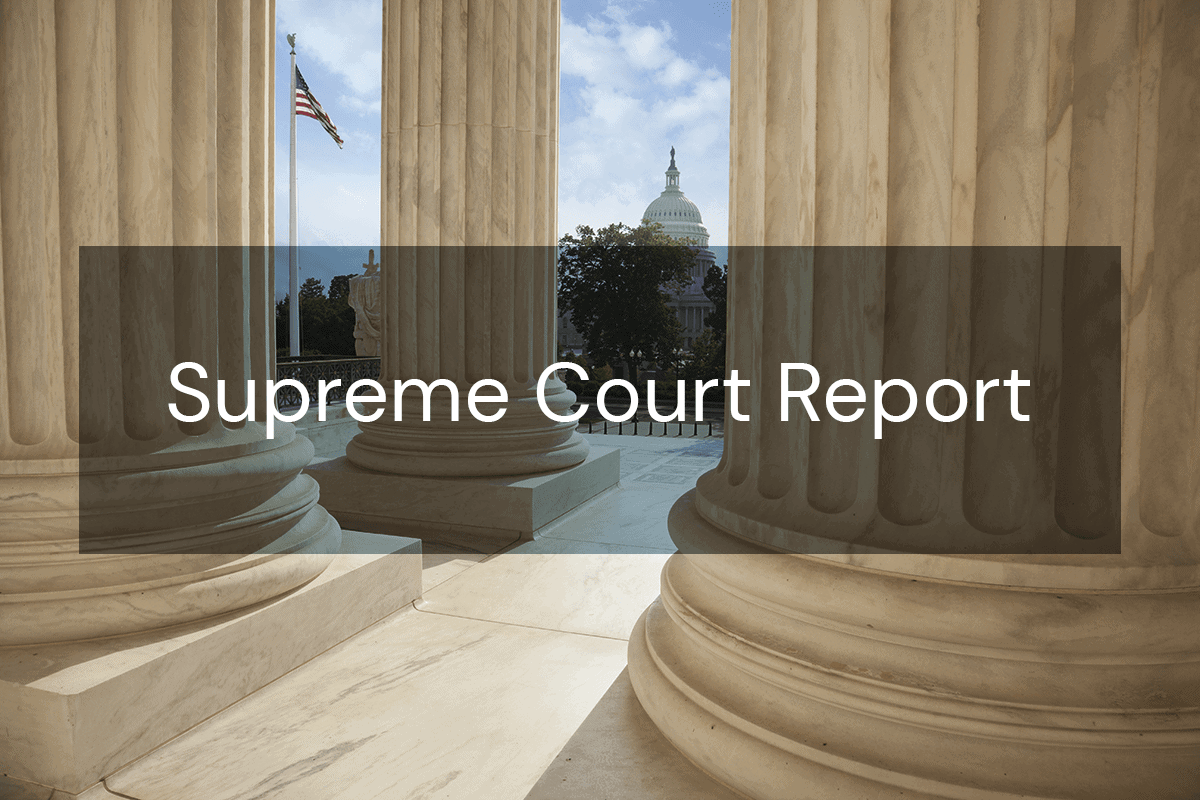-
 Director, Center for Supreme Court AdvocacyNational Association of Attorneys General
Director, Center for Supreme Court AdvocacyNational Association of Attorneys General

This Report summarizes opinions issued on April 28 and May 2, 2022 (Part I); and cases granted review on April 25 and May 2, 2022 (Part II).
Opinion: Cummings v. Premier Rehab Keller, P.L.L.C., 20-219
Cummings v. Premier Rehab Keller, P.L.L.C., 20-219. In a 6-3 decision, the Court held that emotional distress damages are not recoverable under the Rehabilitation Act of 1973 and the Patient Protection and Affordable Care Act. Petitioner Jane Cummings is a deaf and legally blind consumer who primarily communicates in American Sign Language (ASL). She sued respondent Premier Rehab, a recipient of federal funds, after it declined her request to provide an ASL interpreter at physical therapy appointments, “telling Cummings that she could communicate with the therapist using written notes, lip reading, or gesturing.” Cummings alleged that Premier Rehab violated the Rehabilitation Act and the Affordable Care Act by discriminating against her on the basis of disability. The district court dismissed the complaint, finding that the only compensable injuries were for emotional harm and that such injuries were not recoverable to enforce either statute. The Fifth Circuit affirmed. In an opinion by Chief Justice Roberts the Court affirmed, agreeing that there was no basis to maintain emotional distress damages under the antidiscrimination laws at issue here.
The Rehabilitation Act and Affordable Care Act were passed pursuant to the Spending Clause of the Constitution, under which “Congress has broad power . . . to set the terms on which it disburses federal funds,” such as prohibiting recipients from discrimination on the basis of disability. These statutes do not expressly provide a private right of action to sue for enforcement, but the Court has “’found an implied right of action.’” The Court has also addressed the silence on available remedies by treating Spending Clause legislation and funding as a contract between recipients and the federal government that “condition[s] an offer of federal funding on a promise by the recipient not to discriminate[.]’” This “contract-law analogy,” according to the Court, “rests . . . on ‘whether the [recipient] voluntarily and knowingly accepts the terms of th[at] ‘contract.’” “A particular remedy is thus ‘appropriate relief’ in a Spending Clause action ‘only if the funding recipient is on notice that, by accepting federal funding, it exposes itself to liability of that nature.’”
Relying on Barnes v. Gorman, 536 U.S. 181 (2002), which held that funding recipients could be held liable for compensatory damages but not punitive damages for violations of antidiscrimination laws, the Court explained that a funding recipient is on notice of (1) remedies “explicitly provided in the relevant legislation,” and (2) “those remedies traditionally available in suits for breach of contract.’” In Barnes, the Court held that punitive damages are not available for violations of Spending Clause statutes, finding “punitive damages to be ‘generally not available for breach of contract,’ despite the fact that such damages are hardly unheard of in contract cases”―such as “where ‘the conduct constituting the breach is also a tort for which punitive damages are recoverable.’” Applying this approach to damages for emotional harm, the Court concluded they are not traditionally available in suits for breach of contract: “It is hornbook law that ‘emotional distress is generally not compensable in contract.’” This means that funding recipients do not have clear notice that they could be liable for emotional harm, and therefore could not give their unambiguous consent to liability.
The Court responded to the argument made by Cummings (as well as the United States and the dissent) that “‘traditional contract remedies’ in fact do ‘include damages for emotional distress,’” namely, “where ‘the contract or the breach is of such a kind that serious emotional disturbance was a particularly likely result.’” The first “fatal flaw[]” with this argument, said the Court, is that it moves away from the general rule about usual forms of relief and looks for “‘more fine-grained’ or “other unusual, even ‘rare’ remedies’” that may be recoverable for breach of a contract. The Court rejected this inquiry as inconsistent with Barnes and said it could not “be squared with our contract analogy case law,” which serves “only as a potential limitation on liability[.]” Moreover, a focus on traditional forms of relief eliminated any need to “dive through the treatises, 50-state survey, or speculative drawing of analogies . . . to anticipate their availability.” The second flaw, found the Court, is that even if funding recipients were aware that they could be subject to “rare” remedies like emotional distress damages, they still lacked sufficient notice because the availability of such damages “does not reflect the consensus rule among American jurisdictions,” which views such damages as “highly unusual” for contracts. Finally, the Court ruled that, “even if it were appropriate to treat funding recipients as aware that they may be subject to ‘rare’ contract-law rules that are ‘satisfied only in particular settings,’ funding recipients would still lack the requisite notice that emotional distress damages are available under the statutes at issue” because “the Restatement’s formulation—that such damages are available where ‘the contract or the breach is of such a kind that serious emotional disturbance was a particularly likely result,’ see Restatement (Second) of Contracts §353—does not reflect the consensus rule among American jurisdictions.”
Justice Kavanaugh filed a short concurrence, joined by Justice Gorsuch, stating that “[t]he dueling and persuasive opinions [by the majority and dissent] illustrate . . . that the contract-law analogy is an imperfect way to determine the remedies for this implied cause of action.” The better method, he contended, would be to “focus on a background interpretive principle rooted in the Constitution’s separation of powers.” Specifically, “Congress, not this Court, creates new causes of action. See Alexander v. Sandoval, 532 U. S. 275, 286–287 (2001). And with respect to existing implied causes of action, Congress, not this Court, should extend those implied causes of action and expand available remedies.” “[T]hat background interpretive principle,” said Justice Kavanaugh, “also counseled against awarding damages for emotional distress.”
Justice Breyer dissented, joined by Justices Sotomayor and Kagan. Justice Breyer found it “difficult to square the Court’s holding with the basic purposes that antidiscrimination laws seek to serve.” He agreed with use of the contract-law analogy but concluded that a funding recipient had sufficiently clear notice that even without financial injuries, emotional harm such as indignity and humiliation could result from discrimination itself. The dissent also argued that the general contract principle of compensating the aggrieved party to put him in a position as if the contract had been performed supported recovery for emotional distress but not for punitive damages, which “go beyond” compensating the lost expectation and put the injured party in a better position.
“[M]ost importantly,” maintained the dissent, “expected losses from the breach of a contract entered for nonpecuniary purposes might reasonably include nonpecuniary harms.” Citing examples of contracts for nonpecuniary purposes like marriage and agreements for the handling of a body or delivery of a sensitive telegram, Justice Breyer argued that “emotional distress damages are compensatory because they make good on the wrong done.” (Internal quotation marks omitted.) The dissent similarly viewed a contract intended to “eradicate invidious discrimination” as clearly nonpecuniary, and believed it was likely foreseeable that discrimination would cause serious emotional harm like humiliation and embarrassment. The dissent therefore believed that funding recipients had sufficiently clear notice of potential liability. The dissent further contended that this outcome does not conflict with Barnes because the comparison between punitive damages and emotional damages is an inapt one. First, the Restatement attributes the availability of punitive damages to tort law but attributes damages for emotional harm to contract law. Second, punitive damages, unlike damages for emotional harm, do not serve contract law’s central purpose of compensating the injured party for their expected loss. The dissent concluded by highlighting that the majority opinion “creates an anomaly” between the statutes at issue here and other antidiscrimination statutes for which Congress expressly permitted recovery of damages for emotional distress.



